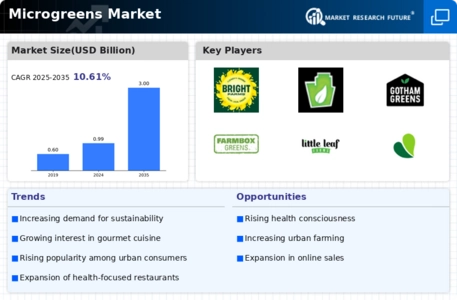Market Growth Projections
The Global Microgreens Market Industry is projected to experience substantial growth over the coming years. With a market value of 0.99 USD Billion anticipated in 2024, the industry is expected to expand significantly, reaching an estimated 3 USD Billion by 2035. This growth trajectory suggests a compound annual growth rate of 10.6% from 2025 to 2035. Factors contributing to this growth include rising health consciousness, sustainability trends, culinary innovations, and increased consumer education. The combination of these elements positions the microgreens market as a dynamic sector within the broader agricultural landscape.
Rising Health Consciousness
The Global Microgreens Market Industry is experiencing a surge in demand driven by increasing health consciousness among consumers. Individuals are becoming more aware of the nutritional benefits associated with microgreens, which are rich in vitamins, minerals, and antioxidants. This trend is particularly evident in urban areas where health-focused diets are gaining traction. For instance, microgreens are often incorporated into salads, smoothies, and gourmet dishes, appealing to health-conscious consumers. As a result, the market is projected to reach 0.99 USD Billion in 2024, reflecting a growing preference for nutrient-dense food options.
Culinary Innovation and Trends
The Global Microgreens Market Industry is significantly impacted by culinary innovation and evolving food trends. Chefs and restaurants are increasingly incorporating microgreens into their menus to enhance flavor, presentation, and nutritional value. This trend is particularly pronounced in fine dining establishments where the aesthetic appeal of dishes is paramount. Additionally, the rise of plant-based diets has further fueled the demand for microgreens as a versatile ingredient. As culinary creativity continues to flourish, the market is likely to witness a compound annual growth rate of 10.6% from 2025 to 2035, indicating robust growth prospects.
Consumer Education and Awareness
Consumer education plays a crucial role in shaping the Global Microgreens Market Industry. As awareness regarding the health benefits and culinary uses of microgreens increases, consumers are more inclined to incorporate them into their diets. Educational initiatives by producers, health organizations, and culinary schools are helping to demystify microgreens and promote their versatility. Workshops, cooking classes, and online resources are becoming more prevalent, fostering a deeper understanding of how to utilize microgreens effectively. This growing awareness is likely to drive market growth, potentially leading to a market value of 3 USD Billion by 2035.
Sustainable Agriculture Practices
Sustainability is becoming a pivotal factor influencing the Global Microgreens Market Industry. The cultivation of microgreens typically requires less water and space compared to traditional crops, aligning with the increasing demand for environmentally friendly agricultural practices. Urban farming initiatives and vertical farming systems are gaining popularity, allowing for year-round production of microgreens. This method not only reduces the carbon footprint but also enhances food security in urban settings. As sustainability becomes a priority for consumers and producers alike, the market is expected to grow significantly, potentially reaching 3 USD Billion by 2035.
Increased Availability and Accessibility
The Global Microgreens Market Industry benefits from improved availability and accessibility of microgreens through various distribution channels. Supermarkets, health food stores, and online platforms are increasingly offering a diverse range of microgreens, making them more accessible to consumers. This trend is particularly relevant in regions where fresh produce is traditionally limited. The expansion of e-commerce has also facilitated the direct-to-consumer model, allowing producers to reach a broader audience. Consequently, the market is poised for growth as consumers seek convenient and fresh options, contributing to the projected market value of 0.99 USD Billion in 2024.



















